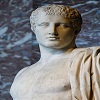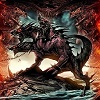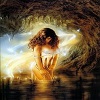Gorgons
The three vicious female mythical creatures
Perhaps the most popular gorgon in Greek mythology is Medusa, the only mortal among the three sisters who had snakes for hair and who's gaze would turn anyone into stone.
She was famously decapitated by Perseus who was armed with a mirror and scythe.
THE GORGONES (or Gorgons) were three powerful, winged daemons named Medousa (Medusa), Sthenno and Euryale. Of the three sisters only Medousa was mortal, and so it was her head which King Polydektes of Seriphos commanded the young hero Perseus to fetch. He accomplished this with the help of the gods who equipped him with a reflective shield, curved sword, winged boots and helm of invisibility.
When he fell upon Medousa and decapitated her, two creatures sprang forth from the wound - the winged horse Pegasos and the giant Khrysaor. Perseus fled with the monster's head in a sack, and with her two angry sisters following close upon his heels.
According to late classical poets, Medousa was once a beautiful maiden who was transformed by Athena into a monster as punishment for lying with Poseidon in her shrine. However, early Greek writers and artists, simply portray her as a monster born of a monstrous family.
The three Gorgones were depicted in ancient Greek vase painting and sculpture as winged women with broad round heads, serpentine locks of hair, large staring eyes, wide mouths, the tusks of swine, lolling tongues, flared nostrils, and sometimes short coarse beards. Medousa was humanised in late classical art with the face of a beautiful woman. In mosaic art her full face was wreathed around with coiling snakes and adorned with a pair of small wings sprouting from the brow.
The poet Hesiod seems to have imagined the Gorgones as reef-creating sea-daemones, personifications of the deadly submerged reefs which posed such a danger to ancient mariners. As such he names the three petrifyers daughters of dangerous sea-gods. One also bears a distincty marine name, Euryale, "she of the wide briny sea". Later writers continue this tradition when they speak of reefs being created where Perseus had set the Gorgon's head and where he had turned a sea monster to stone.
In other motifs, the Gorgon Medousa was a portrayed as a storm daemon whose visage was set upon the storm-bringing aigis-shield of Athene. The two ideas were probably connected, with sea storms driving ships to destruction upon the reefs.
Some say there was a but a single goat-like Gorgon, a daughter of the Sun-God, who was slain by Zeus at the start of the Titan-War to form his stormy aigis shield.
In older motifs the Gorgones were probably connected with Demeter Erinys (the Fury) and the three Erinyes. These were the bringers of drought, the withering of crops and the coming of famine. In myth the beheading of Medousa saw the release of two beings - Pegasos (of the springs) and Khrysaor (golden blade). This story might have represented the ending of drought with the release of the waters of springs (pegai) and the growth of golden (khryse) blades of grain. Demeter herself was titled Khrysaoros in Homeric poetry, further suggesting a close link between the name and blades of corn.
[1]












